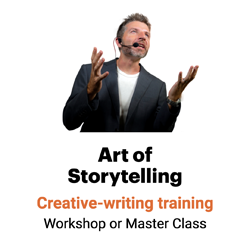Take it apart; put it back together
In her memoir The Year of Magical Thinking, Joan Didion describes a moment with her late husband, the novelist John Gregory Dunne:

“When we were living in Brentwood Park we fell into a pattern of stopping work at four in the afternoon and going out to the pool,” she writes. “He would stand in the water reading (he reread Sophie’s Choice several times that summer trying to see how it worked) while I worked in the garden.”
“Amateurs plagiarize. Real writers steal.”
— T.S. Eliot, 20th-century American poet
That’s how good writers get better: by studying work they admire until they “see how it works.”
Did you ever take your Mom’s toaster apart to figure out how it worked? You can do the same thing with writing.
Choose a piece you love from your clip file of writing samples. Then take it apart and put it back together until you understand why you like it and what the writer did to make it that way.
Find the template.
In my clip file, I have a short piece about Las Vegas from Time magazine. I collected it for a single sentence:
Lounge music may be to the symphony what Velveeta is to cheese — but hey! — it’s all part of what makes Las Vegas great.
Take it apart. Here’s what I love about that passage:
- The two comparisons (Lounge music = symphony; Velveeta = cheese)
- The fact that those comparisons are also compared to each other
- The word “Velveeta” (cheesy brand names are always fun)
- The full sentence with an exclamation point between dashes
Put it back together. So now you know what to do: Write a sentence with two comparisons compared to each other, a cheesy brand name and a full sentence with an explanation point between dashes in the middle. The template looks like this:
Blank may be to blank what (funny brand name) is to blank — hypershort sentence! — something.
When I asked participants in a workshop to model that passage, one came up with:
Youth hostels may be to the Hyatt what love beads are to diamonds — but hey! — it’s all part of what makes your Adventures Ltd. vacation great.
Practice X-ray reading.
The Poynter Institute’s editorial guru Roy Peter Clark calls this approach “X-ray reading.”
“Using the method of close reading,” he writes, “I find a passage that intrigues me, put on my X-ray glasses, and peer beneath the surface of the text to view the invisible machinery of language, syntax, rhetoric, and critical thinking that creates the effects I experience as a reader. I then forge what I see into a writing tool.”
Steal the techniques (not the words).
When I was in graduate school, one of my favorite journalism professors, Rick Musser, confessed that he’d always loved the introduction to The Dane Curse, a detective novel by Dashiel Hammett:
It was a diamond all right, shining in the grass, about two dozen feet from the blue brick.
Someday, he promised, he’d find a way to adapt that image into one of his own pieces. Years later, when I was editing a piece he wrote for a magazine I worked at, I saw that he’d made good on his promise. Here’s his opening paragraph for a piece on a millionaire scrap man of Kansas City:
Sure enough, those are pennies down there in the muck, their mangled edges glinting in the Blue Valley sun.
That’s reading like a writer: getting inspiration from the very best writers, then adapting it — not adopting it, but adapting it — to your own work.
I know I don’t need to tell you that we’re not talking about plagiarism here. I once outlined this approach to a group of writers in a seminar. At the break, one of the writers pulled me aside and proudly explained how she collects Wall Street Journal headlines about personal finance then uses them verbatim as headlines for the personal finance articles in her own newsletter.
Eeek! I said. That’s not modeling. That’s plagiarizing.
The key to modeling is to steal the technique, not the words. Adapt — don’t adopt — others’ approaches.
Try it yourself. Feel free to borrow and improve on other people’s techniques. It’s a widely practiced form of flattery. Take whatever you can, and keep T.S. Eliot’s advice close to heart.
“Amateurs plagiarize,” he said. “Real writers steal.”
Learn more about reading to write.
- Read like a writer; write like a reader. To build your writing skills, read widely — from Ernest Hemingway to Stephen King. (Even if you’re not writing fiction.) Read voraciously: not just books on writing craft, but creative, writing, short stories and other types of books.
- Make time to read. Read a lot and write a lot. And when reading books, short stories or other brand messages, look for technique, don’t just get swept away in the story. Start a clip file of writing you love, so you can reverse engineer it.
- Absorb the prose. Type up passages you love or sleep on them. Call it “modeling lessons.”
___
Sources: “Stop the Music,” Time, Aug. 21, 1989

Leave a Reply